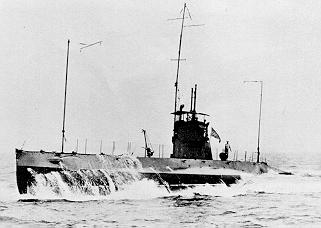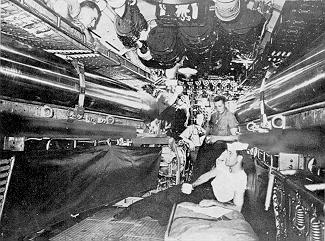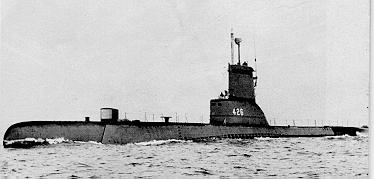The Saga of the
SUBMARINE
Page 6
THE UNITED STATES entered World War I with a total of 24 diesel powered subs. They did not see a great deal of action, and in the small number of encounters with the enemy they were unable to confirm a single victory. The U-boats of Germany, however, were to demonstrate the vital role of the submarine in any future conflict.
 USS Haddock SS 32
USS Haddock SS 32
After the war the Navy continued to build up its submarine force and the Portsmouth Naval Shipyard in New Hampshire became one of the largest submarine builders in America. Between 1924 and 1929 the Portsmouth yard designed and built five 381-foot, V-class submarines and between 1932 and 1941, an additional 22 subs in the 1500-ton category. It was during this period that the first all-welded submarine, USS Pike, was completed. The welded hull allowed Pike to submerge to much greater depths than her predecessors and at the same time provided greater protection against depth-charge attacks.
 Typical WW II Submarine layout
Typical WW II Submarine layout
Radar and sonar were World War II innovations. Both were developed by the English to combat German U-boats, but were incorporated into the submarine to warn of airplane attack and counterattack from surface vessels. Sonar has become the most important of the submarine’s senses. Hydrophones listen for sounds from other ships and the echoes of sound waves signaled from the submarine itself.
 USS Flasher SS 249 High scoring Sub for WW II
USS Flasher SS 249 High scoring Sub for WW II
Toward the end of World War II, the Germans perfected a snorkel device which had been invented by the Dutch years before. This device permitted the running of diesel engines while the ship was submerged. The best storage batteries discharged rapidly and limited submergence time. The snorkel greatly increased underwater endurance, but protruded above the surface and could he detected by radar.Although the U. S. Navy still had a relatively small number of submarines when World War II broke out, this fact did little to dampen the spirits of submariners, and the tales of their successes fill countless pages of history books. When the figures were finally tabulated it was found that American submarines sank five and one-half million tons of Japanese shipping during the war which included over half of the entire Japanese merchant fleet.Another significant fact is that U. S. subs accounted for about 60 per cent (over 1300 ships) of all Japanese tonnage sunk, yet the submarine strength at that time comprised less than two per cent of the entire U. S. Fleet.


Such advancements as sonar, radar and the snorkel came about as a result of the pressures of WW II, and the U. S. Navy was quick to improve these systems and incorporate the lessons of the war into its modern submarine force.One of the first results of this scientific and technological advance was the conversion of WW II Fleet submarines to Guppy types.
 USS Tusk SS 426
USS Tusk SS 426
Guppy type submarine
As part of this conversion the guppies were streamlined to give them more speed and they were fitted with more modern radar and sonar systems.Then, with the introduction of nuclear power, the submarine of old became a true submarine – a ship with greater endurance than its human engineers.Many records have already been chalked up by the nuclear powered submarine, and many more are still to come.

Next page|Previous Page
© Ric Hedman 1998
- 2007
The author
is a Member of The HTML Writers Guild

PigBoats.COMTM
Mountlake Terrace, WA
webmaster at pigboats.com








